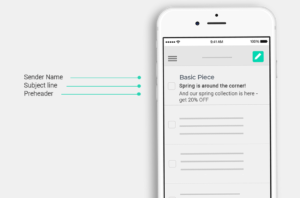Hi friend! Are your Email Marketing Copy Writing tips up to scratch?
As part of our continued focus on email marketing this month, we discuss the do’s and don’ts of your email content – what do you want to say, and how should you say it?
Content has the power to make or break your email campaign, especially when dealing with a huge increase in email marketing traffic across a range of industries caused in part by the COVID-19 pandemic as businesses change their comms strategies to adapt. Our browsing habits have changed, and our inboxes are more active than ever, so how do you make an impact? According to Microsoft, you only have 8 or 9 seconds in fact to “wow us”, and it’s only a handful of emails that really make the cut.
How to create email campaigns to achieve your business goals.
We’re featuring some tasty top tips from our Senior Digital Designer and mega email marketing guru Zubair to help ensure that your email campaign is effective. From the top down, here are our recommendations:
1: Who is your email being sent from?
In most cases, your recipients are familiar with your brand name, but not necessarily the name of an individual at that organisation (even the CEO!). We would usually advise to stick to using your brand or company name as the ‘from name’, but if you’re unsure – it’s always a good thing to split test. If you do decide to go for an individual name, then keep it consistent so recipients know that the emails are from you.
2: Nail the Subject Line
Did you know that 47% of email recipients open an email based on the subject line alone? At the same time, 69% of email recipients report email as spam based solely on the subject line. It’s the first, and often the only, opportunity to get your email in front of your audience, so it’s important to get it right. Block captials, overuse of punctuation and a selection of clichéd phrases will often directly turn the viewer off, as will a long-winded subject line that doesn’t get quickly to the point.
Think about your use of emojis in the subject line – could this be a turn on, or turn off for your target audience? Using more than two emojis is generally not recommended, but the odd one could cut through the plain text list of emails in an inbox. If your data allows, it’s also good to use personalisation in subject lines, including your customer’s first name. A carefully-crafted subject line is one of the most important tools for increasing open rates!
3: Don’t ignore your pre-header
The pre-header sits below your subject line, and now displays in most email clients (depending on the individual user’s settings) on both desktops and mobile devices. Our advice is to keep email subject lines short, so effective use of a pre-header can give your recipients another layer of information: a clear indication of what the email contains, and and incentive to open.

4: Compelling Body Copy
Choose your words carefully, keep things short, concise and relevant. The body copy should provide all those compelling supporting details, needed for a recipient to move onto the CTA smoothly. Also, avoid too much industry jargon – it can be a major turn off!
The tone of voice you use will vary according to your industry and your intended audience – do you want recipients to remember your brand as cheeky, formal, traditional, or somewhere in between? Using the right language to connect to your audience and leave a lasting impression is so important. For a seamless customer journey, make sure that your copy aligns with your website and tone of voice used on your social channels. That way, recipients will know what to expect when they click through to find out more.
5: Don’t make it too lengthy…
The optimal length of an email is much debated, but according to Boomerang data, emails between 50 and 125 words had the best response rates, at just above 50% [Insert source or superscript to footnote]. When in doubt, keep emails short, under 200 words.
6: It’s all about the personal touch
Personalisation is key. Focus on your customer, understand their needs… What do they want to receive and when do they want to receive it? 67% of consumers unsubscribe because they are receiving too many irrelevant emails. [Source: Litmus, Adapting to Consumers Definition of Spam report, 2017]
Segmentation is your friend when creating personalised campaigns and will enable you to connect with subscribers. If the subscriber has provided their name, then use it and any other known information. Emails can be segmented so that they are specific to the demographic or interests of the recipient, or they might relate to previous transactions so that you can target similar products that might appeal to them.
Do you know when your recipient’s birthday is? Send them a discount code! Have they made multiple purchases over the past 12 months? Make them feel special by sending them a VIP offer or loyalty scheme. It is quick and easy to make your customers feel like they are receiving an email that is individual to them.
7. Lastly, and probably most importantly…
TEST TEST TEST! What works for one company and audience will not work for another. We have worked on email campaigns that work better sent at 7am, some sent at 7pm, some with an individual from name, and some from a company. Sometimes even we are surprised by the results! It is SO important to test your campaigns, vary the subject lines, the send time and day, the from name and the content. Continue testing as your database grows too, as you might find that your results can shift.
Creativity is key when it comes to email marketing! Do you need a little help cutting through the noise? Speak to Andy for a free email marketing audit to help you thrive!
USEFUL LINKS:
https://www.mailkit.com/resources/blog/5-ways-adding-personalisation-your-email-marketing-strategy?gclid=EAIaIQobChMImfrpqZbT8AIVk2DmCh06KQM4EAAYAiAAEgL0OfD_BwE
https://expresswriters.com/how-to-write-content-for-email-marketing/
https://www.google.co.uk/amp/s/www.campaignmonitor.com/resources/guides/high-performing-email/m/
https://www.wordstream.com/blog/ws/2014/03/31/email-subject-lines




